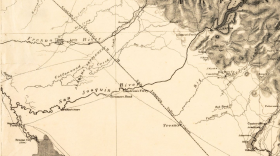It was the first superspeedway west of the Mississippi River, and a small but important part of NASCAR and Indy Car racing history. Today on KVPR’s Central Valley Roots, the story of Hanford’s Marchbanks Speedway.
Back in the years after World War II, Hanford farmer R.L. Marchbanks had vision. He’d turn his farmland southeast of Hanford into a horse-racing track, complete with legalized betting. When he was unable to get that project approved, he turned to the growing sport of auto racing and in 1950 started building Marchbanks Speedway.
It stood southeast of Hanford, near Highway 43 and Idaho Avenue. The first version of the course was a half-mile dirt track. It caught the attention of NASCAR founder Bill France Sr. who held a 200 mile Grand National Race there in 1951.
The track was extended the modernized several times over the next two decades, including a road course, and ultimately, a high-banked, 1.4 mile superspeedway. In the 1960s the name changed to the Hanford Motor Speedway. Throughout the 1960s it hosted many NASCAR and Indy Car races with the world’s top drivers like A.J. Foyt, Parnelli Jones and Mario Andretti.
But the track was never a huge financial success. The track held its last race in 1969. It was torn down in 1984 and turned back into farmland.






